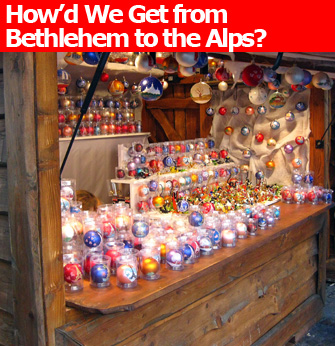 |
|
In Paris, nothing says “Christmas” like pointless products on sale in an ersatz Tyrolean chalet. |
Christmas in France is not much different from Christmas in the United States. Just like in the United States, people buy sawed-off evergreens to put in the living room, where they serve as ground zero for the gift explosion and coat the carpet with pine needles. Just like in the United States, they hang XXL knee socks by the fireplace and tell their children that Santa is going to slide down the chimney to leave them presents in the middle of the night.
They do not, however, blackmail their offspring with the threat of getting coal in their stockings if they don’t toe the line. The French Santa is exemplarily eco-conscious: he simply skips the homes of the naughty, thus saving on fossil fuels and reducing his carbon bootprint.
Just like in the United States, French people decorate their homes and offices with holly and ivy and try to corner their hotter distant relatives and coworkers for a little seasonal sexual harassment under the mistletoe. Just like in the United States, on Christmas Day families get together for a big turkey dinner and the grownups get merry on mulled wine. (Despite the French fondness for artery-clogging foodstuffs, they have yet to discover the virtues of eggnog.)
And they sing carols. Or rather carol, singular.
I hate to say it, but I’m afraid the Anglophones have the French beat from here to Christmas when it comes to carols. Think of all the traditional English Christmas songs we have, from “Away In a Manger” to “We Three Kings.” Wikipedia lists no fewer than 47 English carols worthy of the name (I’m not counting commercial outpourings of piety like “Rockin’ Around the Christmas Tree”), compared with a paltry seven in French. Even if you add the Gallicized versions of “Silent Night” and “Jingle Bells,” with their retrofitted French lyrics, that’s still barely enough repertoire to fill the B side of a Singing Nun album.
Not only that, but out of the seven, there is only one that I have ever actually heard of, or heard sung: Il Est Né Le Divin Enfant. It means “He is Born, the Blessed Child,” but during my first Christmas season in France, I thought they were singing, “He Is a ‘Nose,’ the Divine Infant.”
I thought it was divinely French, foreseeing the Christ child’s future career as a perfume maker rather than a carpenter. But it makes sense – the kid was surrounded by sheep and cattle, after all, and a crowd of people who had just made a long journey in the desert and couldn’t get a room with bath. It’s no wonder two of the three items on his wish list were fragrance ingredients.
Speaking of improvised temporary housing, there is one tradition here in Paris that I have never seen outside of Europe, namely the Marché de Noël – the Christmas Market. Or rather markets, plural, because there are more than a dozen of them in different spots all over town, each consisting of dozens of supposedly quaint-looking stands selling allegedly festive products.
There are a couple of things that I don’t get about the Marché de Noël concept. For starters, the goods on sale tend to fall into two categories: tacky tchotchkes that nobody who hasn’t been hitting the mulled wine would ever buy…
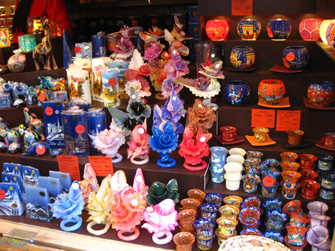 |
|
I don’t even know what some of these things are, but I know I don’t want them in my apartment. |
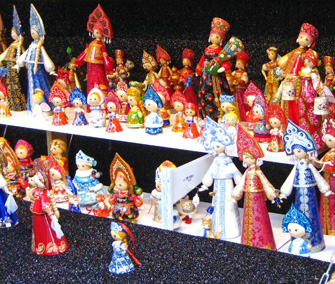 |
|
Are these figurines supposed to be Russian? Balinese? Tasteful? |
… or everyday products that you could easily find in any one of a number of stores:
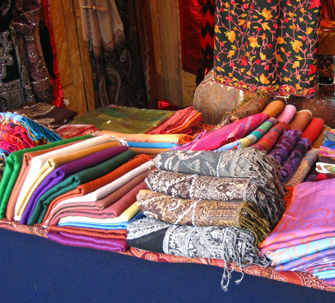
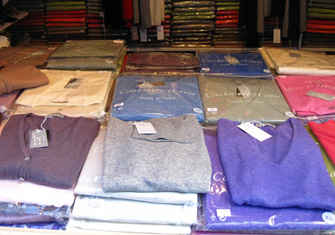
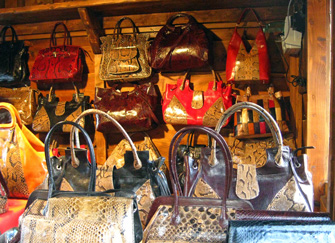
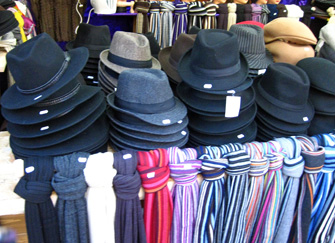 |
|
Handbags, hats and scarves, sweaters, more scarves… Why not toilet paper and truck tires? |
So what’s the point? Except for a couple of huts selling actual Xmas flotsam like tree decorations and Santa hats, there is nothing to link the markets directly to the holiday. They could set up the stands in March and call it the Easter Market, in July and call it the Bastille Day Market, or in September and call it the Talk Like a Pirate Day Market. Or all year round and just call it the Market.
But the thing that baffles me most about the Christmas Markets is their infrastructure: all of the stands, all over town, are designed in the same faux-Alpine-chalet style. Other than evoking snow, what exactly does this have to do with Christmas? Was there a fourth Wise Man whose camel broke down and who was bringing the Baby Jesus a pair of lederhosen?
Also, a Marché de Noël is by definition a short-term installation, but the stalls are built to last. Look at this one:
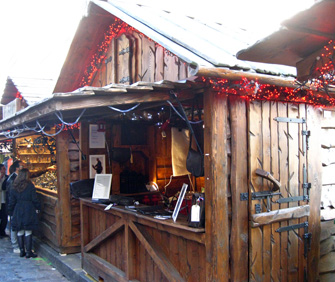 |
|
Massive, solid wood walls and roof. Rain gutters and an attic. And a thick door with wrought iron hinges and lock. If a tornado hits Paris, I’d rather be in there than in my own basement. |
Not only are the stands substantial structures, but there are enough of them to form an actual Alpine town. This year there are 20 chalets at Place d’Italie, 25 at Saint Germain des Prés, 35 at Nation, 40 at Saint Sulpice, 40 across from Gare Montparnasse, 50 at Sacre Coeur, 100 at Trocadéro, 170 on the Champs-Elysées, and no fewer than 350 transforming La Défense into a snowless, slopeless ski resort from Kitschland. On top of that, there must be at least another hundred or so scattered about in little enclaves of cutesiness like the mini-Marché de Noël at Place des Abbesses. Like I said, all over town.
So here’s my question: upwards of a thousand of these Yule log cabins are put up in Paris every year, but only for the Christmas Markets – I have never seen them in use for any other event. Where are they the rest of the year?
I suppose they’re just kept in storage someplace, but that’s a lot of warehousing. I would bet that the building(s) that are currently filled with Christmas chalets 49 weeks of the year could easily house half of the homeless population of Paris. And the chalets themselves, being sturdy and at least as large as a Parisian maid’s room, could house the other half.
Think about it: Unabomber Ted Kaczynski lived in less square footage for 25 years, and we never heard him complain. Oh wait – I guess we did. But not about his living quarters.
We know where the robins go in October, where the Parisians go in August and where our money goes in April, but where do all the chalets go in January? It’s a Christmas mystery.
Reader Mimi Taylor writes: “I enjoyed that, very humorous. How about a take on the Turkish toilets: what restaurants have them, so I can avoid the place.”
Editor’s note: click here to read David’s article on French toilets.
Reader Mary Beth Dietrick writes: “Outside of Europe? There’s one in New York in Bryant Park; one in Chicago in Daley Plaza. I agree with everything else in the article!”
Reader Judy Knestis writes: “What a great article on the Marchés de Noël in Paris. I was both nostalgic and laughing out loud, having wandered through them many times on our various stays in Paris. I always felt the same way about those strange Swiss-structures and the variety of awful things for sale (good stuff to eat however). Thanks for bringing a laugh (and a tiny tear) to my day. I would love to be there right now.”
© 2011 Paris Update
An album of David Jaggard’s comic compositions is now available for streaming on Spotify and Apple Music, for purchase (whole or track by track) on iTunes and Amazon, and on every other music downloading service in the known universe, under the title “Totally Unrelated.”
Note to readers: David Jaggard’s e-book Quorum of One: Satire 1998-2011 is available from Amazon as well as iTunes, iBookstore, Nook, Reader Store, Kobo, Copia and many other distributors.
